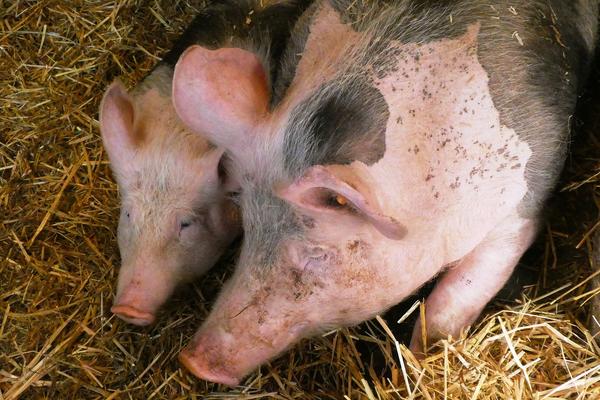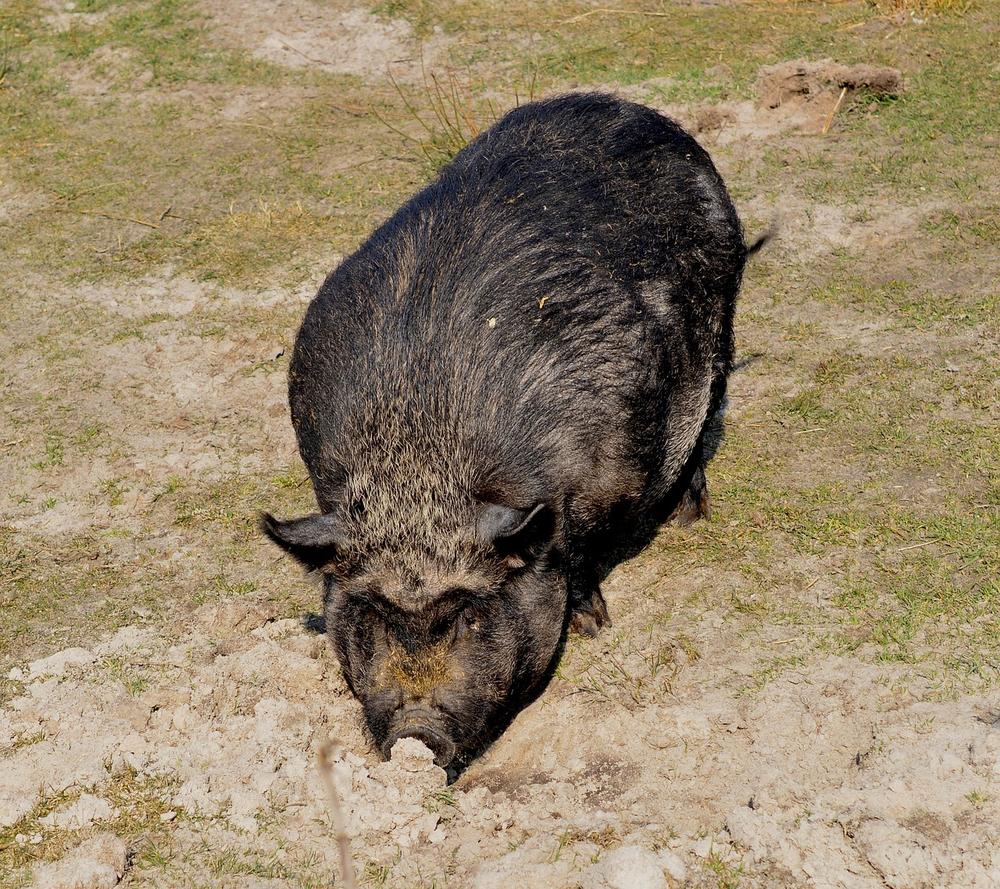Do Pigs Chew Cud?

Ever wondered if pigs chew cud?
Curiosity swirling, mind full of questions, you find yourself deep in the rabbit hole of farm animal dietary behaviors. 😄
But fear not!
Let's delve into the intriguing world of swine mastication together.
Get ready to quench that thirst for knowledge, my friend.
Let's begin.
What Are the Similarities Between Pigs and Ruminants in Chewing?
Pigs and ruminants have similarities and differences in terms of chewing:
- Dietary preferences: You see, pigs are omnivores, so they can eat both plants and animals. But ruminants, they stick to a plant-only diet.
- Chewing ability: Here's where ruminants have the upper hand. They have this neat cud-chewing process that helps them break down food better than pigs. Pigs, on the other hand, rely on their pointy teeth to do the job.
- Saliva composition: Saliva plays a role in digestion, and ruminants produce saliva with neutralizers that fight stomach acids and help with microbial growth. Pigs, well, their saliva is more about grinding up food into smaller bits.
- Nutritional content: Now, pig food these days is all about making pork tastier and adding more nutrients. As pigs get older, their diets can include things like rice, wheat, alfalfa, and soybeans for carbs and proteins. Ruminants, though, get their protein from bacterial proteins produced during fermentation in their rumen.
- Digestive speed: Pigs are fast metabolizers. They zip through their food in about 4 hours. Ruminants, on the other hand, take longer because of their reliance on microbial fermentation.
But here's something that might pique your curiosity...
While pigs have a simple stomach for digestion, ruminants possess a four-compartment stomach and exhibit a unique behavior.
Let's explore how this distinction sets them apart and impacts their dietary restrictions...
Do Pigs Have Multiple Stomachs and Chew Cud?
Pigs have a single chamber for digestion, unlike ruminants that chew cud and have four stomach compartments. Unlike cud-chewing animals, pigs do not regurgitate their partially digested food. Additionally, religious dietary restrictions limit the consumption of pork for a significant portion of the global population.
But pigs, my dear readers, are a whole different story.
Now picture this: cows, sheep, and their crew who chew cud have not one, but four compartments in their stomach for digestion! That's twice as many compartments as the average pig.
However, pigs?
Well, pigs like to keep it simple.
They only have one single-chambered stomach, known as a monogastric stomach.
Unlike cows and other ruminant animals that chew cud and spit out partially digested food, pigs skip that step altogether.
So no cud-chewing action for these little piggies!
You might wonder why, right?
Here's the deal:
Cud-chewers like cows spend a good portion of their day munching on fibrous plants, breaking them down into smaller, more manageable pieces.
Afterwards, they regurgitate this mix of saliva-soaked cud and continue the digestion process in their multiple stomachs.
But pigs—they're just delightful—don't have to worry about cud chewing.
Their single-chambered stomach takes care of everything at once.
It's efficient, quick, and allows them to focus on important piggy activities like wallowing in the mud or enjoying tasty treats.
On another note, please keep in mind that some religions, such as Judaism and Islam, have dietary restrictions that forbid the consumption of pork products.
So, take cultural considerations into account when savoring a delectable bacon sandwich.
And it gets more fascinating when we delve into the specifics of how pigs digest their food.
Are you ready to uncover the intriguing details of a pig's digestive system?
Let's explore further and discover what sets pigs apart from other animals in terms of digestion.
Do Pigs Regurgitate Their Food?
Hey there!
Let's talk about pigs and their eating habits.
Unlike ruminants, pigs don't regurgitate or chew partially digested food.
Nope, that's not their jam. Pigs do not engage in cud chewing, which means they don't bring up food to chew it again.
They have other things on their mind!
Instead, pigs use their esophagus to transport food from mouth to tummy.
It's all about those muscular contractions, baby.
Once the food reaches the stomach, it goes through some digestive magic.
Then it's off to the large intestine.
But hold onto your hat, because this is where water and mucus are added.
Hey, everybody needs a little hydration and lubrication, right? Finally, after all that jazz, the pigs bid adieu to their food via the evacuation route aka pooping it out. So, to sum it up: pigs aren't into regurgitating their grub.
Nope, they're all about the straightforward process.
Mouth, stomach, intestines, exit.
Easy peasy.
There you have it, my friend.
Now you know how pigs handle their meals without any fancy schmancy cud-chewing.
Now, you might be wondering how the digestive process of pigs compares to that of other animals and what impact it has on the quality of their meat.
Well, let me fill in the gap for you and shed some light on the fascinating world of pig digestion...
Do Pigs Have a Complex Digestive System?
Pigs possess a digestive system that is less intricate compared to ruminant animals like cows and sheep, but they are still efficient at digesting food. The process takes approximately 4 hours, and a pig's diet significantly impacts the quality of its meat.
Let me fill you in on the digestive system of pigs.
Pigs aren't as complex as cows, but their gut isn't exactly plain.
You know, pigs are omnivores, just like us humans.
They can eat all sorts of foods.
But hold on, that doesn't mean they should be constantly fed garbage or compost.
I mean, don't these piggies deserve better?
Water is also essential for pigs, especially nursing mothers.
They need 5 to 10 liters of water each day.
So ensure these piggies stay hydrated!
Here's what happens during the pig's digestion process:
First, we've got the mouth, esophagus, stomach, small intestine, and large intestine.
Through these parts, food breaks down into nutrients that pigs can use.
In the stomach, carbohydrates, proteins, and fats get broken down by digestive chemicals.
Then, in the small intestine, the food continues to break down even further.
This is where nutrients get absorbed with the help of secretions from the pancreas and liver.
Now, when piglets are still young, we want them to start off right.
So we feed them natural grains, fresh fruits, and vegetables.
That way, we promote healthier and cleaner meat.
Who wouldn't want that?
But once piglets are weaned off their momma's milk and onto solid food, they need a well-balanced mix.
And that's precisely where pig feed comes in.
They require proteins, carbs, vitamins, and minerals to grow big and strong.
You know, there has been some controversy surrounding pig farming lately.
Some practices are seen as inhumane, with the animals kept in less-than-ideal conditions.
However, the industry is slowly changing.
Bigger producers are phasing out gestation crates, while smaller ones focus on free-roaming and natural feeding methods.
By the way, just so you know, pigs chewing cud like cows is absolutely not true. They don't have that ability.
And if you're curious to learn more about the fascinating world of pigs, I invite you to discover What Senses Do Pigs Rely On.
In this informative guide, I share valuable insights into the unique senses that pigs rely on for survival.
It's an essential read for anyone interested in understanding these remarkable animals on a deeper level.
Differentiating the Digestive System of Pigs and Ruminants
Pigs and ruminants, such as cows and sheep, possess different stomachs.
Ruminants have multiple compartments, pigs have a simpler stomach (just like humans).
Due to this, pigs cannot digest cellulose since they lack additional compartments.
Thus, pigs are incapable of chewing their cud like ruminants.
Consequently, pigs cannot break down cellulose found in grasses and grains unlike ruminants.
This distinction is crucial!
Unlike ruminants, pigs do not have specialized fermentation chambers for digestion.
Interestingly, there exist various theories for why some cultures ban pork.
Theories span concerns over trichinosis, unsuitability for desert conditions, food competition, and rulers seeking control.
Regardless of the validity of these theories, one certainty prevails:
Pigs possess distinctive digestive systems.
Learn more: Are you curious to know if pigs can recognize themselves in a mirror? If so, I invite you to explore the fascinating topic of Mirror Self-Recognition in Pigs. Discover the surprising abilities of these intelligent animals and unravel the mysteries of their self-awareness.
However, you need to understand the significance of pigs' inability to chew cud in certain religious practices...
What Does it Mean to Chew Cud?
Ruminant animals, like cows and sheep, have this process called chewing cud you might have heard of.
It's when they regurgitate partially digested plant material from their stomach back into their mouth for some more munching.
But here's the twist: pigs, despite being fascinating creatures themselves, do not chew cud.

And because of that, certain religious beliefs - held by Jews and Muslims - consider pig meat unclean.
In these religious practices, chowing down on pork is a big no-no.
It's considered forbidden or unclean due to the pig's lack of cud chewing abilities.
Pretty interesting stuff, right?
Pigs and Chew Cud: Key Takeaways
Key Takeaways:
- Ruminant animals like cows and deer chew their cud more effectively than non-ruminants like pigs.
- Ruminants produce saliva with neutralizers that aid in microbial growth.
- Pigs are omnivores and were domesticated around 10,000 years ago.
- Leviticus prohibits the consumption of pork due to pigs being deemed unclean animals in the past.
- Pigs have a simpler digestive system compared to ruminants.
- Pigs do not chew their cud and do not regurgitate food.
- The pig's stomach metabolizes food swiftly within 4 hours.
- Pigs can eat a variety of foods but must not be constantly fed garbage or compost.
- Water intake is crucial for pigs, especially nursing mothers.
- The quality of a pig's meat depends on its diet.
- Modern pig farming practices are aimed at improving conditions for the animals.
- Pigs cannot digest cellulose found in grasses and grains.
- Certain religious beliefs consider pigs unclean and forbid their consumption.
And that's all for today folks.
You made it to the end of my blog post, so I wanted to ask: Did you enjoy it? I put a great deal of time and effort into writing informative and all-encompassing blog posts. It's a labor of love for me, so if you could kindly click on any of the social sharing icons to spread the word about this blog post, I would be extremely grateful. Thank you!
Until next time,
-Chris Campbell